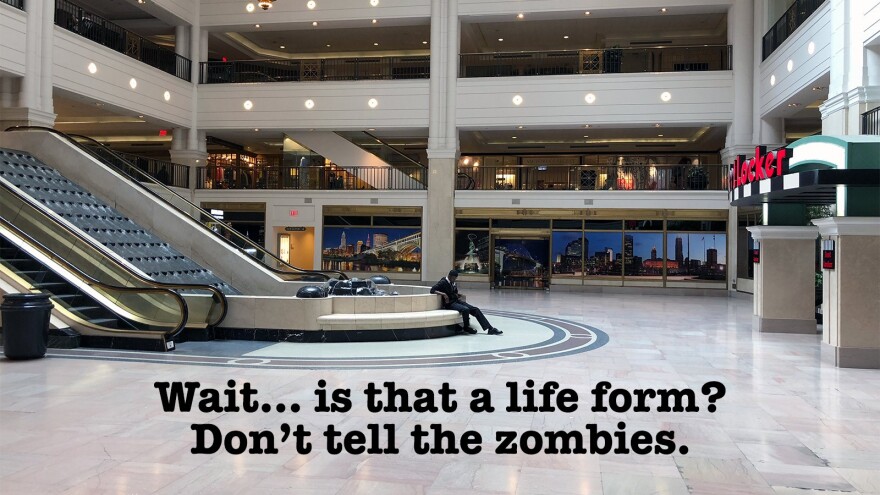Thanks for checking out "The Downtowner," about Cleveland's newest, oldest neighborhood. Downtown Cleveland is trendy. Are Clevelanders ready for this? That's what we explore in our podcast about the rise in interest in living Downtown, and what the city will need to do to sustain this growth. Check out all of our episodes on our show page.
Subscribe: iTunes | Google Play | Stitcher | NPR One| Feed
Social: Facebook | Twitter | Instagram
I used to take acting classes somewhere on Cleveland's East Side when I was a teen. I wasn't old enough to drive, so I took mass transit. I'd catch the once-an-hour bus from Strongsville to Cleveland Hopkins Airport, where I'd catch the Rapid Transit downtown to the Terminal Tower and transfer for another bus that would take me to some long-forgotten place on Mayfield Road.
The best part of this tedious trip was passing through Terminal Tower. This was in the late 1970s, when it was still Cleveland Union Terminal. I remember the dimly-lit marble-floored passageways leading up to the street and Public Square. There was a Dodd Camera store, if memory serves me. There was a shoe repair place. But they were lonely retailers in an otherwise empty, gloomy place that reeked of urine. I loved it, though, because I could see the glorious old bones of the place. I loved it because I felt the inherent wisdom of having stores for folks like me who were passing through, who needed a shoe shine or some bubble gum or a newspaper.
I used to think, "Why aren't these stores open? Why isn't anyone here?"
It's hard to underestimate how thrilled I was when Tower City opened. Most of Cleveland was excited, too.
The developer, Forest City, brought back glamour and elegance to a part of Downtown that had seemed lost to history and weighed down by despair.
But from the beginning, there were seeds of doubt. The New York Times noted at the time that it was "clearly going against the tide" of decades of suburban shopping mall development. The Avenue at Tower City opened just as shoping mall development was beginning to slow due to rising land prices, a stagnating retail industry, a tight credit market and vigorous competition from other malls.
"There are often five or six regional malls in the same metropolitan area," noted the Times. Remember, this was 1990.
"There is no question, a lot of strip centers -- and malls for that matter -- should not have been built," one strip center developer said.
Can the same be said for Bedrock LLC's plan to remake Tower City?
Bedrock, the real estate development company owned by Dan Gilbert, the billionaire founder of Quicken Loans and the majority owner of the Cleveland Cavaliers, bought the Tower City mall for $56.5 million. That was in 2016. There have been no major changes to the mall since then. There are not likely to be any for another two years, Ken Till told us.
Till is the vice president of development for the Detroit-based Bedrock's Cleveland properties. He said Bedrock's architects are still mulling over what to do with its shiny, white and gold, three-story elephant.
One thing it won't be, he said, is an indoor mall. "We're really looking at mixed-use development," he said. That means office space, school space, maybe a tech incubator.
It means finding a new spot for Tower City Cinemas' nine screens, currently tucked away deep inside the complex, one that would provide street-level access from Public Square or Prospect Ave. It means keeping it competitive, should a new movie theater go up a few blocks away in the East Flats.Till said that could mean international or art house films instead of Tower City Cinemas' current offering of mainstream studio releases like "Mission: Impossible—Fallout" or "The Spy Who Dumped Me."
It means making it easier to get around Tower City's three levels, connected at strange intervals by elevators and escalators. Till calls it "an interesting configuration." I call it maddening, like navigating an interior designed by M.C. Escher. (George highlights some of Tower City's conundrums in the video below. There's something there, trust me. Click on the Play arrow.)
And, yes, it means retail. Experiential retail, Till called it. That's code for stores that offer more than products, that offer experiences, connection, community. Stores that would make people want to come Downtown and be a part of the excitement. More important, Till said, they'd be stores that would cater to Downtown's burgeoning residential population, the folks who already have excitement —just check out the clubs and restaurants on E. 4th St. on a warm summer night—and just want to pick up some wood glue or a dog leash or a new saucepan.
Does all this sound like a plan that will save Tower City's mall? That depends on whether we can stop thinking of malls as a string of stores with a couple of national, brand-name anchor tenants and a food court. That kind of mall is dying. Ken Till is suggesting something new and different, something we may not even know we are in need of, as we click through clothing options on Amazon, load up our virtual shopping carts and hit the Order button.
Save the mall at Tower City? No, kill it, and save Tower City.






